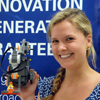Fellows
 Jasmin Hume
Jasmin Hume
Ph.d (2nd year), Chemical and Biological Sciences
Year in graduate program: 2nd year
Research Topic:Protein engineering
Partner School:Community Partnership Charter School, Mott Hall Bridges Academy
Partner Teacher:Ivonne Cintron, William Principle
Email Jasmin
Research
Under the guidance of Professor Jin Kim Montclare, Jasmin is pursuing her PhD in Materials Chemistry, in the department of Chemical and Biological Sciences. Her research concerns protein-based materials, which offer a level of structure and specificity unique to biological systems. Through protein engineering, she has designed two types of protein nanowires which will exhibit electronic properties through templation of (1) energy-transferring gold nanocrystals and (2) magnetic ferric oxide nanocrystals on α-helical cartilage oligomeric matrix protein coiled coil (COMPcc) variants.
These proteins are characterized using the tools of biotechnology and chemistry, while hybrid organic-inorganic protein nanowires will also be characterized using methods common to materials science. The self-assembling protein fibers used as the substrate materials for metal templation provide a platform for the construction of future materials composed of biological macromolecules. Conducting and magnetic protein materials will find applications in biosensors, medical imaging, and as potential alternative materials for energy harvest and storage.
Figure: Figure: Jasmin prepares a buffer solution to be used in DNA experiments.
Integration in The Class Room
Jasmin integrates her work in the classroom through weekly presentations and experiments with elementary and middle school classes. She links state-mandated topics to her scientific research. She develops hands on experiments directly connected to her laboratory research. Jasmin has also employed the use of light and temperature sensors to measure various physical and chemical properties of diverse materials. Moreover, Jasmin has used molecular modeling kits with the students to explain the connection between chemical structure and physical properties of water and various lipids in the classroom. These experiments and demonstrations allow the students to understand how unseen parameters, such as the chemical makeup of a material, can be studied through the use of sensors and robots. It is these types of connections that she hopes will inspire students to become further engaged in science, engineering, and technology, specifically in the fields of protein, biological, and chemical engineering.
Figure:Figure: Students use a Q-tip to streak bacteria from their hands onto Petri dishes.
1 - AMPS Fellow; 2 - CBRI Fellow